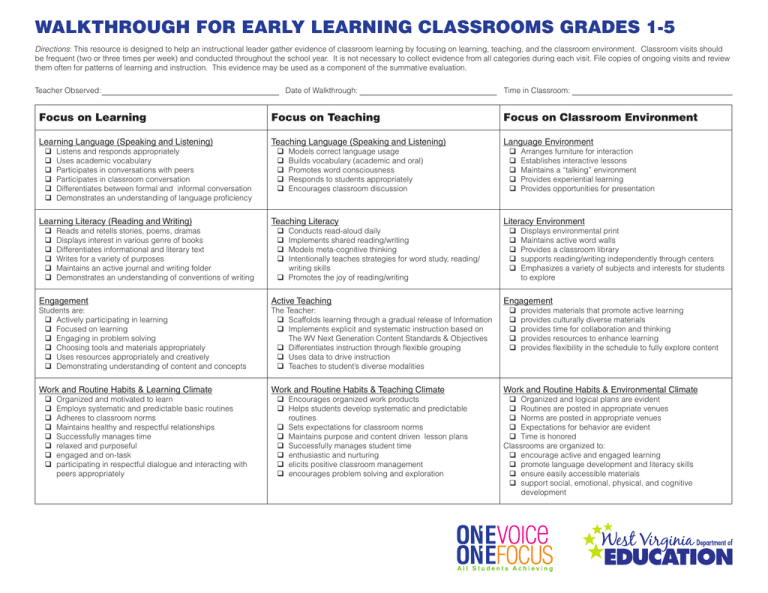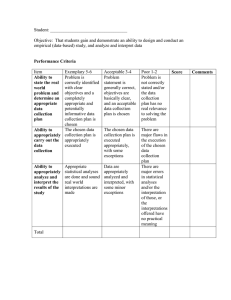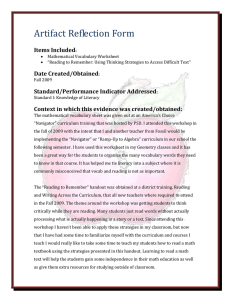WALKTHROUGH FOR EARLY LEARNING CLASSROOMS GRADES 1-5
advertisement

WALKTHROUGH FOR EARLY LEARNING CLASSROOMS GRADES 1-5 Directions: This resource is designed to help an instructional leader gather evidence of classroom learning by focusing on learning, teaching, and the classroom environment. Classroom visits should be frequent (two or three times per week) and conducted throughout the school year. It is not necessary to collect evidence from all categories during each visit. File copies of ongoing visits and review them often for patterns of learning and instruction. This evidence may be used as a component of the summative evaluation. Teacher Observed: Date of Walkthrough: Time in Classroom: Focus on Learning Focus on Teaching Focus on Classroom Environment Learning Language (Speaking and Listening) Teaching Language (Speaking and Listening) Language Environment Learning Literacy (Reading and Writing) Teaching Literacy Literacy Environment Engagement Active Teaching Engagement Work and Routine Habits & Learning Climate Work and Routine Habits & Teaching Climate Work and Routine Habits & Environmental Climate Listens and responds appropriately Uses academic vocabulary Participates in conversations with peers Participates in classroom conversation Differentiates between formal and informal conversation Demonstrates an understanding of language proficiency Reads and retells stories, poems, dramas Displays interest in various genre of books Differentiates informational and literary text Writes for a variety of purposes Maintains an active journal and writing folder Demonstrates an understanding of conventions of writing Students are: Actively participating in learning Focused on learning Engaging in problem solving Choosing tools and materials appropriately Uses resources appropriately and creatively Demonstrating understanding of content and concepts Organized and motivated to learn Employs systematic and predictable basic routines Adheres to classroom norms Maintains healthy and respectful relationships Successfully manages time relaxed and purposeful engaged and on-task participating in respectful dialogue and interacting with peers appropriately Models correct language usage Builds vocabulary (academic and oral) Promotes word consciousness Responds to students appropriately Encourages classroom discussion Conducts read-aloud daily Implements shared reading/writing Models meta-cognitive thinking Intentionally teaches strategies for word study, reading/ writing skills Promotes the joy of reading/writing The Teacher: Scaffolds learning through a gradual release of Information Implements explicit and systematic instruction based on The WV Next Generation Content Standards & Objectives Differentiates instruction through flexible grouping Uses data to drive instruction Teaches to student’s diverse modalities Encourages organized work products Helps students develop systematic and predictable routines Sets expectations for classroom norms Maintains purpose and content driven lesson plans Successfully manages student time enthusiastic and nurturing elicits positive classroom management encourages problem solving and exploration Arranges furniture for interaction Establishes interactive lessons Maintains a “talking” environment Provides experiential learning Provides opportunities for presentation Displays environmental print Maintains active word walls Provides a classroom library supports reading/writing independently through centers Emphasizes a variety of subjects and interests for students to explore provides materials that promote active learning provides culturally diverse materials provides time for collaboration and thinking provides resources to enhance learning provides flexibility in the schedule to fully explore content Organized and logical plans are evident Routines are posted in appropriate venues Norms are posted in appropriate venues Expectations for behavior are evident Time is honored Classrooms are organized to: encourage active and engaged learning promote language development and literacy skills ensure easily accessible materials support social, emotional, physical, and cognitive development WALKTHROUGH FOR EARLY LEARNING CLASSROOMS GRADES 1-5 Directions: This resource is designed to help an instructional leader gather evidence of classroom learning by focusing on learning, teaching, and the classroom environment. Classroom visits should be frequent (two or three times per week) and conducted throughout the school year. It is not necessary to collect evidence from all categories during each visit. File copies of ongoing visits and review them often for patterns of learning and instruction. This evidence may be used as a component of the summative evaluation. Teacher Observed: Indoor Environment The room is clean, orderly and uncluttered, comfortable, and provides access to fresh air. The room is free of safety hazards Classroom environment has student work, creations, and representations (photographs, documentation boards, experience stories, etc.) of their work displayed. Children have access to learning tools and materials. Materials are in plentiful supply so that multiple children can use them. Children have choices about the materials they select. Materials meant for children are easily accessible and logically organized. Furnishings and equipment are in good repair and are safe. Furniture is appropriately sized. Each child has a place to keep personal belongings. There is adequate storage for both adults and students. There are spaces in the room where children can work on their own, in small groups, and in larger groups. Activity areas and pathways permit ease of movement through the room. The room is designed so teachers can easily maintain a global overview of the room even when working with individuals or small groups of students. Date of Walkthrough: Literacy A majority of the lesson is spent listening to, reading, writing, or speaking about text(s). The text(s) are above the complexity level expected for the grade and time in the school year. The foundational skills being taught are aligned to the standards for this grade. (Prek-2nd) Instruction and materials address foundational skills by attending to phonological awareness, concepts of print, letter recognition, phonetic patterns and word structure. (Prek-2nd)(Note: not all elements will be addressed in each lesson.) Provide opportunity of students to talk and work together cooperatively in small groups. (50%-60% of instructional time should be used to collaborate and produce.) The teacher explicitly attends to strengthening students’ language and reading foundational skills by using complete sentences, good eye contact, clear speech, and correct grammar. Questions and tasks in all content areas require students to use evidence from text to demonstrate understanding and to support their ideas about the text. These ideas are expressed through a variety of means (e.g. drawing, writing, dramatic play, speaking). There is a print-rich environment to facilitate vocabulary acquisition and development. Instruction and materials provide opportunities for students to demonstrate understanding of the skills being taught through frequent monitoring of student progress. Time in Classroom: Numeracy Provides a rich variety of informal, integrated opportunities as well as formal activities for children to think mathematically. Limited time spent doing mathematics as an isolated activity; integrate mathematical tools and problems into a variety of classroom activities. Provide various pencil-and-paper opportunities for children to practice recording thought processes, and communicating mathematical ideas. Point out mathematical connections as children engage in reading, social studies, science, music, or art activities. Encourage students to measure with conventional tools like measuring cups, rulers and scales as well as nonconventional units of the same size laid end to end, like paper clips, and fingers. Ask children to pose questions and gather data about themselves, surroundings and their peers, and represent the date using pictures, objects, and graphs. Assess children’s mathematical understandings in multiple ways, including performance tasks, interviews and observations. Teachers teach more than “how to get the answer” and instead support students’ ability to access concepts from a number of perspectives so that students are able to see mathematics as more than a set of mnemonics or discrete procedures.




